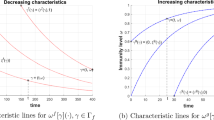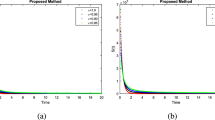Abstract
We study a class of SIRS epidemic dynamical models with a general nonlinear incidence rate and transfer from infectious to susceptible. The incidence rate includes a wide range of monotonic, concave incidence rates and some non-monotonic or concave cases. We apply LaSalle’s invariance principle and Lyapunov’s direct method to prove that the disease-free equilibrium is globally asymptotically stable if the basic reproduction number \(R_0\le 1\), and the endemic equilibrium is globally asymptotically stable if \(R_0>1\), under some conditions imposed on the incidence function f(S, I).








Similar content being viewed by others
References
Agrawal, A., Tenguria, A., Modi, G.: Stability analysis of an SIR epidemic model with specific nonliner incidence rate. Math. Theory Model. 6(1), 45–51 (2016)
Anderson, R.M., May, R.M.: Regulation and stability of host-parasite population interactions: I. Regulatory processes. J. Anim. Ecol. 47, 219–247 (1978)
Bai, Y., Mu, X.: Global asymptotic stability of a generalized SIRS epidemic model with transfer from infectious to susceptible. J. Appl. Anal. Comput. 8(2), 402–412 (2018)
Buonomo, B., Rionero, S.: On the lyapunov stability for SIRS epidemic models with general nonlinear incidence rate. Appl. Math. Comput. 217(8), 4010–4016 (2010)
Capasso, V.: Global solution for a diffusive nonlinear deterministic epidemic model. SIAM J. Appl. Math. 35(2), 274–284 (1978)
Capasso, V., Serio, G.: A generalization of the Kermack–McKendrick deterministic epidemic model. Math. Biosci. 42(1), 43–61 (1978)
Capasso, V., Grosso, E., Serio, G.: I modelli matematici nella indagine epidemiologica. Applicazione all’epidemia di colera verificatasi in Bari nel 1973. Ann. Sclavo 19, 193–208 (1977)
Castillo-Chavez, C., Song, B.: Dynamical models of tuberculosis and their applications. Math. Biosci. Eng. 1(2), 361–404 (2004)
Cui, J., Sun, Y., Zhu, H.: The impact of media on the control of infectious diseases. J. Dyn. Differ. Equ. 20(1), 31–53 (2008)
Guo, H., Li, M.Y., Shuai, Z.: Global stability of the endemic equilibrium of multigroup SIR epidemic models. Can. Appl. Math. Q. 14(3), 259–284 (2006)
Hethcote, H.W.: Qualitative analyses of communicable disease models. Math. Biosci. 28(3–4), 335–356 (1976)
Hethcote, H.W.: The mathematics of infectious diseases. SIAM Rev. 42(4), 599–653 (2000)
Kermack, W.O., McKendrick, A.G.: A contribution to the mathematical theory of epidemics. Proc. R. Soc. Lond. A: Math., Phys. Eng. Sci. 115, 700–721 (1927)
Korobeinikov, A.: Lyapunov functions and global stability for SIR and SIRS epidemiological models with non-linear transmission. Bull. Math. Biol. 68(3), 615–626 (2006)
Korobeinikov, A.: Global properties of infectious disease models with nonlinear incidence. Bull. Math. Biol. 69(6), 1871–1886 (2007)
Korobeinikov, A., Maini, P.K.: Non-linear incidence and stability of infectious disease models. Math. Med. Biol. 22(2), 113–128 (2005)
Lahrouz, A., Omari, L., Kiouach, D.: Global analysis of a deterministic and stochastic nonlinear SIRS epidemic model. Nonlinear Anal.: Model. Control 16(1), 59–76 (2011)
Lahrouz, A., Omari, L., Kiouach, D., Belmaâti, A.: Complete global stability for an SIRS epidemic model with generalized non-linear incidence and vaccination. Appl. Math. Comput. 218(11), 6519–6525 (2012)
Li, T., Zhang, F., Liu, H., Chen, Y.: Threshold dynamics of an SIRS model with nonlinear incidence rate and transfer from infectious to susceptible. Appl. Math. Lett. 70, 52–57 (2017)
Liu, W., Levin, S.A., Iwasa, Y.: Influence of nonlinear incidence rates upon the behavior of SIRS epidemiological models. J. Math. Biol. 23(2), 187–204 (1986)
Mena-Lorca, J., Hethcote, H.W.: Dynamic models of infectious diseases as regulators of population sizes. J. Math. Biol. 30(7), 693–716 (1992)
Muroya, Y., Enatsu, Y., Nakata, Y.: Global stability of a delayed SIRS epidemic model with a non-monotonic incidence rate. J. Math. Anal. Appl. 377(1), 1–14 (2011)
Ruan, S., Wang, W.: Dynamical behavior of an epidemic model with a nonlinear incidence rate. J. Differ. Equ. 188(1), 135–163 (2003)
Sun, C., Lin, Y., Tang, S.: Global stability for an special SEIR epidemic model with nonlinear incidence rates. Chaos, Solitons Fractals 33(1), 290–297 (2007)
Tang, Q., Teng, Z., Abdurahman, X.: A new lyapunov function for SIRS epidemic models. Bull. Malays. Math. Sci. Soc. 40(1), 237–258 (2017)
Van den Driessche, P., Watmough, J.: Reproduction numbers and sub-threshold endemic equilibria for compartmental models of disease transmission. Math. Biosci. 180(1), 29–48 (2002)
Vargas-De-León, C.: On the global stability of SIS, SIR and SIRS epidemic models with standard incidence. Chaos, Solitons Fractals 44(12), 1106–1110 (2011)
Wang, L., Zhang, X., Liu, Z.: An SEIR epidemic model with relapse and general nonlinear incidence rate with application to media impact. Qual. Theory Dyn. Syst., 1–21 (2017)
Wang, X., Liu, S.: An epidemic model with different distributed latencies and nonlinear incidence rate. Appl. Math. Comput. 241, 259–266 (2014)
Wei, C., Chen, L.: A delayed epidemic model with pulse vaccination. Discret. Dyn. Nat. Soc. 2008, 13 (2008)
Xu, R., Ma, Z.: Stability of a delayed SIRS epidemic model with a nonlinear incidence rate. Chaos, Solitons Fractals 41(5), 2319–2325 (2009)
Zhou, X., Cui, J.: Global stability of the viral dynamics with Crowley-Martin functional response. Bull. Korean Math. Soc. 48(3), 555–574 (2011)
Acknowledgements
This work was supported by Sistema Nacional de Investigadores (15284) and Conacyt-Becas.
Author information
Authors and Affiliations
Corresponding author
Rights and permissions
About this article
Cite this article
Avila-Vales, E.J., Cervantes-Pérez, Á.G. Global stability for SIRS epidemic models with general incidence rate and transfer from infectious to susceptible. Bol. Soc. Mat. Mex. 25, 637–658 (2019). https://doi.org/10.1007/s40590-018-0211-0
Received:
Accepted:
Published:
Issue Date:
DOI: https://doi.org/10.1007/s40590-018-0211-0




